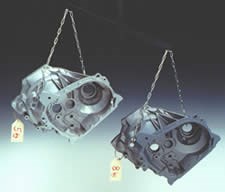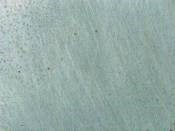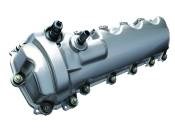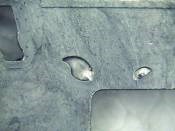Magnesium Applications Abound
Direct EN plating makes it possible
Technological trends in the automotive, electronics and telecommunications industries continue to push product designers toward lighter weight, miniaturization, reduction in the number of components and increased functionality of both components in a device and the device itself. Automakers continue their quest for lighter materials to meet mandated mileage goals. Consumers now expect electronic products to provide multifunctional capabilities, such as telephone, camera, text messaging, personal organizer, mp3 player, alarm and GPS, in one device.
Such miniaturization requires that the various components be combined within a single enclosure. Many of the component parts have been consolidated into single, multifunctional parts in order to:
- Keep manufacturing costs down
- Simplify assembly
- Further reduce size
- Allow greater design freedom for the final product.
In the electronics industry, for example, the function of structural housings once was solely to protect and support the internal parts of a device. Today, that same housing is a fraction of the size and cross-section of the original but still needs to support the internal parts with the same degree of protection while also serving as an EMI/RFI shield and heat sink!
This change in part design and functionality has resulted in more stringent requirements for materials of construction in terms of strength, weight, and manufacturability. The required properties for these new designs include:
- High stiffness in thin cross-sections
- High strength-to-weight ratio
- High dimensional stability
- High thermal and electrical conductivity
- Ease of manufacturing.
Versatile Mg
Magnesium is the primary material being used to meet these stringent demands in more and more applications. The eighth most abundant element in the Earth’s crust, it is much lighter than steel, copper, and even aluminum, rivaling the density of plastic. Magnesium has a high strength-to-weight ratio, allowing the design of very thin and light parts with high strength. Dimensional stability, combined with ease of forming and casting, make it suitable for high-volume production of intricate parts. Table 1 summarizes some of the material’s properties.
Although magnesium has many desirable properties, it is also easily attacked by corrosive materials because it is one of the most electrochemically active materials. Until recently, this property has limited use of magnesium in applications where corrosive environments are encountered. Usually this issue is remedied by a coating to protect it from the outside environment.
A number of coating technologies exist for protecting magnesium. Each technology has benefits and has found acceptance in various industrial applications. Some of these technologies, and their advantages and limitations, are outlined in Table 1. The ultimate choice of coating depends upon the final performance requirements of the component and the cost restrictions imposed upon the project.
Magnesium has been plated with electrolytic coatings since the 1950s. One of the pioneers in magnesium plating was The Dow Metal Products Co., which developed a series of pretreatments and plating systems for various alloys. These systems generally consisted of hexavalent chromium-based etches, hydrofluoric acid based activators, zincate, and cyanide copper strikes prior to additional topcoats. When tightly maintained and controlled, they provided very viable systems for the successful plating of magnesium.
In today’s environmentally sensitive world, however, it is increasingly difficult to set up new lines utilizing these types of materials, and RoHS legislation has restricted the use of certain materials in the plating processes. Environmentally conscious companies are banning the use of hexavalent chromium in finishing processes, and many countries and municipalities are making it virtually impossible to set up lines containing cyanide chemistries. This necessitates development work on new processes for the pretreatment and coating of magnesium and its alloys.
The most common magnesium alloy currently used in die-cast applications is AZ91D. The material contains 9 wt% aluminum and 1 wt% zinc, and has excellent castability and good mechanical properties. In the as-cast condition, AZ91D has a surface that is very heterogeneous due to the formation of Mg-Al intermetallic compounds during melting, casting and cooling. These intermetallic compounds can set up strong galvanic corrosion cells with magnesium, resulting in accelerated corrosion of the magnesium substrate.
Plating Magnesium
The four important processes key to obtaining optimal adhesion and corrosion protection for an electroless nickel deposit on alloy AZ91D are:
- Pretreatment process capable of cleaning, etching, and removing surface alloying elements to render the surface as pure as possible
- Conversion coating process, which seals and prevents oxidation of the magnesium surface
- Electroless nickel process with a very high tolerance to magnesium exposure
- Surface drying and annealing for 1 hr at 375°F to develop full adhesion.
The first stage of pretreatment must remove any oils and soils that may have settled onto the part surface before delivery to the plating line. Typically, high-detergent alkaline soak cleaners are used. Magnesium is resistant to attack by alkaline solutions and is therefore relatively unaffected by exposure to these cleaners. Failure to remove surface oils completely results in uneven etching and activation of the surface during later pickling processes. This could result in local areas of poor adhesion as well as the presence of corrosion cells and high deposit porosity, which ultimately affect product performance.
The next steps in the preparation of magnesium for plating involve exposing and removing the surface alloying elements while depositing a thin protective film onto the magnesium. This prevents formation of a detrimental oxide film. Conventional etches used to expose the components of the magnesium alloy historically contained high concentrations of hexavalent chromium in the form of chromic acid and nitric acid blends. Fortunately, proprietary, RoHS-compliant etches can perform a similar task without the use of hexavalent chromium.
| Table 1 Magnesium Coating Technologies | |
| Technology | Comments |
| Chemical Conversion Coating | Good corrosion protection High throughput Soft coating; not wear-resistant Coating is non-conductive |
| Anodizing | Hard coating is wear resistant Good corrosion protection Good throughput Coating is non-conductive |
| Physical vapor deposition (PVD) | Wide variety of deposits available for hardness, decorative, etc. Coverage limited to simple geometries due to line of sight application. Limited throughput High capital costs |
| Painting | Wide variety of colors Good corrosion protection Good throughput Coating is soft Coverage limited to simple geometries due to line of sight application. Coating is non-conductive |
| Electroplating | Variety of coating materials available Good wear and corrosion resistance High conductivity Good throughput Difficult to plate complex geometries and blind areas, thus reducing corrosion resistance |
| Direct Electroless Nickel Plating | Coverage of complex geometries Good hardness and wear resistance High conductivity High throughput Can be top-coated |
After etching, parts are immersed in an activator solution that removes smut generated in the etching process. In general, conventional and proprietary activators contain high concentrations of fluoride that effectively “de-smut” the magnesium surface, leaving it clean and relatively pure. The high fluoride content of the solutions also deposits a thin, protective magnesium fluoride coating that slows formation of unacceptable oxide films.
Next, a conversion coating is applied. Similar to a zincate on aluminum, the conversion coating prevents the magnesium surface from forming an oxide film, which would compromise adhesion of subsequent coatings. Conventional processes utilize a zincate specifically designed for magnesium followed by a cyanide copper strike that leaves the zincate film intact. The cyanide copper deposit then acts as a protective barrier between the magnesium substrate and the subsequent electroless nickel layer.
In direct plating of EN on magnesium, immersion of the zincated magnesium into the electroless nickel bath typically removes the zincate film, exposing the magnesium to potential attack by the components of the EN solution. The EN solution is also exposed to potential reactions with bare magnesium; this can result in inconsistent deposit adhesion and instability of the EN bath. The current technology incorporates application of a conversion coating specifically designed to withstand immersion in the EN solution and remain as a barrier layer between the magnesium and electroless nickel deposit.
After conversion coating, the magnesium substrate is immersed in the electroless nickel solution for deposition of the primary protective layer. The most common approaches have used conventional EN systems modified with the addition of a fluoride source to improve solution performance.
As bare magnesium is placed into a conventional EN solution, it is quickly attacked and corroded by the bath components. Upon dissolution, the magnesium quickly reacts with orthophosphite, the by-product of hypophosphite oxidation, to form insoluble precipitates. These precipitates cause many issues, including:
- Formation of excess porosity in the plated deposit that contributes to poor corrosion performance and adhesion
- Rapid consumption of the stabilizers in the electroless nickel solution resulting in bath instability
- Plate-out
- Shortened bath life
- Inconsistent appearance.
| Table 2 EN Over AZ91D Test Results | |
| Test |
Results (Specifications) |
| Cross-hatch/tape test with Scotch 610 tape, as-plated | Pass |
| Cross-hatch/tape test with Scotch 610 Tape after 24 hr NSS |
Pass |
| 4 hr NSS per ASTM B 117, 168 hr humidity (40°C, 93% RH) |
Pass (<5% corrosion) |
| 24 hr NSS, continuous per ASTM B-117 | Pass (<5% corrosion) |
| 3 cycles of 8 hr NSS, 16 hrs idle | Pass (<5% corrosion) |
| Topcoated with bright acid Cu, bright Ni and trivalent Cr | Pass |
| 72 hr NSS with EN/Cu/EN | Pass (<1% corrosion) |
| Quench tested 190°C to 25°C | Pass; no adhesion loss |
It is understandable that platers of magnesium routinely get only one or two metal turnovers from their EN baths.
To overcome premature precipitate formation, it is critical that the EN solution be designed for magnesium exposure, whether plating directly or indirectly on magnesium. The solution must also be capable of quickly initiating, sealing, and building a deposit with high integrity over the substrate surface.
After the initial EN deposit has been established, several options exist to meet a variety of industrial requirements. The main advantage of plating EN directly onto magnesium prior to top coating is that the EN deposit covers all surfaces and protects the magnesium from attack by other plating systems. This is especially true for complex shaped parts that electrolytic plating and paint systems cannot reach.
Performance
Direct EN plating of magnesium, either as a stand-alone coating or in combination with others, has the demonstrated ability to meet adhesion, appearance, and corrosion standards currently in place. There are, however, key factors unrelated to the plating process that can greatly influence the quality of the plated part.
The most important of these is the quality of the cast magnesium part. In the case of AZ91D, which is a highly suitable alloy for plating, a caster can render parts out of this alloy useless for plating simply by the way the parts are cast.
The main casting defects that make a magnesium part difficult to plate are porosity, incomplete mold filling and flash. Plating solutions are unable to penetrate and adequately coat surfaces with defects from incomplete mold filling or high porosity, and the result is a discontinuous deposit with open pathways for corrosive media to enter and directly attack the magnesium substrate. Flash, although completely coated with the EN deposit, remains quite fragile and can easily break off during handling. This results in exposure of the magnesium substrate, which is then easily attacked by corrosion.
With well-cast parts, good results are obtainable in terms of adhesion, appearance, and corrosion resistance. Table 2 lists some typical results, showing that direct plating of EN on magnesium, as a stand- alone coating or in combination with other topcoats, provides the designer with multiple alternatives to meet current and future requirements.
OMG Electronic Chemicals, LLC
Related Content
An Overview of Electroless Nickel Plating
By definition, electroless plating is metal deposition by a controlled chemical reaction.
Read MoreLiquid Chrome Vs. Chromic Acid Flake
Contemplating how to continue offering chromic acid services in an increasingly stringent regulatory world? Liquid chrome products may be the solution you’re looking for.
Read MoreTrivalent Chrome Overview
As the finishing industry begins to move away from the use of hexavalent chromium to trivalent chromium, what factors should finishers consider as they make new investments? Mark Schario, chief technology officer for Columbia Chemical offers a helpful overview of this complicated topic.
Read MoreProducts Finishing Reveals 2024 Qualifying Top Shops
PF reveals the qualifying shops in its annual Top Shops Benchmarking Survey — a program designed to offer shops insights into their overall performance in the industry.
Read MoreRead Next
A ‘Clean’ Agenda Offers Unique Presentations in Chicago
The 2024 Parts Cleaning Conference, co-located with the International Manufacturing Technology Show, includes presentations by several speakers who are new to the conference and topics that have not been covered in past editions of this event.
Read MoreEducation Bringing Cleaning to Machining
Debuting new speakers and cleaning technology content during this half-day workshop co-located with IMTS 2024.
Read MoreEpisode 45: An Interview with Chandler Mancuso, MacDermid Envio Solutions
Chandler Mancuso, technical director with MacDermid Envio discusses updating your wastewater treatment system and implementing materials recycling solutions to increase efficiencies, control costs and reduce environmental impact.
Read More



















.jpg;maxWidth=300;quality=90)








